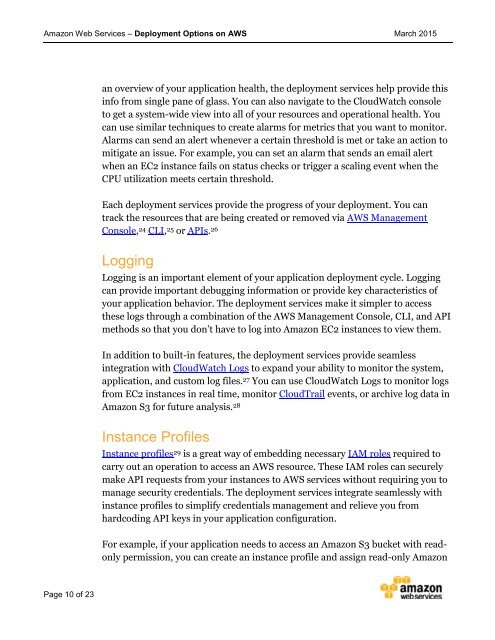kadirtest
Create successful ePaper yourself
Turn your PDF publications into a flip-book with our unique Google optimized e-Paper software.
Amazon Web Services – Deployment Options on AWS March 2015<br />
an overview of your application health, the deployment services help provide this<br />
info from single pane of glass. You can also navigate to the CloudWatch console<br />
to get a system-wide view into all of your resources and operational health. You<br />
can use similar techniques to create alarms for metrics that you want to monitor.<br />
Alarms can send an alert whenever a certain threshold is met or take an action to<br />
mitigate an issue. For example, you can set an alarm that sends an email alert<br />
when an EC2 instance fails on status checks or trigger a scaling event when the<br />
CPU utilization meets certain threshold.<br />
Each deployment services provide the progress of your deployment. You can<br />
track the resources that are being created or removed via AWS Management<br />
Console, 24 CLI, 25 or APIs. 26<br />
Logging<br />
Logging is an important element of your application deployment cycle. Logging<br />
can provide important debugging information or provide key characteristics of<br />
your application behavior. The deployment services make it simpler to access<br />
these logs through a combination of the AWS Management Console, CLI, and API<br />
methods so that you don’t have to log into Amazon EC2 instances to view them.<br />
In addition to built-in features, the deployment services provide seamless<br />
integration with CloudWatch Logs to expand your ability to monitor the system,<br />
application, and custom log files. 27 You can use CloudWatch Logs to monitor logs<br />
from EC2 instances in real time, monitor CloudTrail events, or archive log data in<br />
Amazon S3 for future analysis. 28<br />
Instance Profiles<br />
Instance profiles 29 is a great way of embedding necessary IAM roles required to<br />
carry out an operation to access an AWS resource. These IAM roles can securely<br />
make API requests from your instances to AWS services without requiring you to<br />
manage security credentials. The deployment services integrate seamlessly with<br />
instance profiles to simplify credentials management and relieve you from<br />
hardcoding API keys in your application configuration.<br />
For example, if your application needs to access an Amazon S3 bucket with readonly<br />
permission, you can create an instance profile and assign read-only Amazon<br />
Page 10 of 23
















